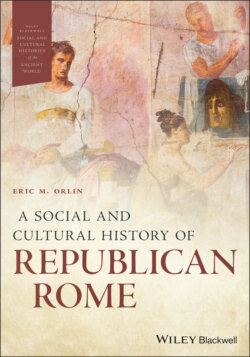Читать книгу A Social and Cultural History of Republican Rome - Группа авторов - Страница 20
Political Issues: Using Coins to Tell Your Story
ОглавлениеIn 2011, a Roman coin, similar to the one shown in Figure 1.6, sold for over $500,000 at auction in Long Beach, California. What could make an old chunk of silver so valuable?
This coin provides a unique view into the debate among Roman politicians in the years following the death of Julius Caesar in 44 BCE. When Brutus and Cassius led a group of senators to kill Caesar in the Senate house, was it an act of unwarranted murder or the legitimate removal of a would-be tyrant? Did it undermine the foundations of a civil society or was it necessary to protect the Roman state? The coin reveals the argument for the latter.
On the obverse, or front of the coin, we find the head of Brutus, identified by the abbreviation BRUT IMP, or Brutus Imperator. Around the lower left side of the coin we find the name L. (for Lucius) Plaetorius Cestianus. This coin was thus minted by Plaetorius, a middling Roman politician who clearly supported Brutus, whom he identifies as a successful military general; at this point in Roman history imperator had not yet come to mean “emperor.” The family of Plaetorius is known to have minted coins during this period, and here Plaetorius uses his position to advocate for a political cause.
The reverse, or back of the coin, depicts two daggers along with the inscription EID MAR; specifying the Ides of March makes clear that the daggers are meant to symbolize the weapons used to kill Caesar. Between the daggers is an image of a cap, known to the Romans as a pileus. In Roman society, when an enslaved person was given their freedom, a part of the ceremony involved placing this cap on the head of the newly freed citizen. The coin thus suggests that by killing Caesar with the daggers, the entire Roman state had been freed from slavery. Brutus was killed in battle in 42 BCE, so we can date this coin with precision between 44 and 42 BCE. Because Brutus’ side lost the war, we do not have many sources offering their viewpoint in Caesar’s death; in fact we have very few of these coins because the victors melted down all the ones they could find, which explains why a single coin could be worth a half million dollars. The coin is valuable both to historians and to collectors.
We also have coins showing the views of Brutus’ opponents, Mark Antony and the young Octavian. In the summer of 44 BCE a comet appeared in the skies over Rome, and Caesar’s supporters argued that this comet represented the ascension of Caesar to the heavens, and that Caesar should thus be worshipped as a god, much as Romulus was worshipped as a god. After the conclusion of the Roman civil wars, Octavian, now known as Augustus, issued a series of coins referencing this star with the legend DIVUS IULIUS, or “the deified Julius.” These coins thus made the claim for Caesar’s divinity and, by association, Augustus’ own descent from a god. In a world of limited communication, these coins served as perhaps the best way to share a message.
